Growing Up in Scotland: Birth Cohort 2. Results from the First Year
This Growing up in Scotland report provides a detailed insight into the first set of data collected from the study’s second birth cohort – representative of all children born in Scotland between 1st March 2010 and 28th February 2011 – around the time they were all aged 10 months old.
Chapter 8 Childcare
Paul Bradshaw, ScotCen Social Research
8.1 Introduction
Currently in Scotland children are entitled, from the term following their third birthday, to attend a nursery or preschool setting (a council nursery or private sector partner provider) without charge for the statutory requirement of at least 12.5 hours a week or 475 hours a year over 38 weeks. Any other care (for children under 31⁄2 years, or outside school time) is outwith statutory requirements.
The 2008 Concordat agreement between the Scottish Government and COSLA (Convention of Scottish Local Authorities) emphasised the autonomy of local authorities, so that some local authorities aggregate the weekly hours available, allowing parents to use the free entitlement as they wish. Others limit availability to 2.5 or 5 hours a day, leaving families to pay for additional care. In some areas children can start nursery, free, before their official date of entitlement; in others they can start but must pay a small fee (Children in Scotland 2011).
The investment in early years - including childcare provision - stems from the National Outcomes published by Scottish Government in 2007, which articulate the Government's purpose; specifically, National Outcome 5 states: "Our children have the best start in life and are ready to succeed" (Scottish Government 2011). Contributing to the delivery of this Outcome is the Early Years Framework (EYF). The EYF shapes the content and delivery of multiple forms of childcare; one practical result is the Scottish Family Information Service. Established in 2011, the service offers a centralised gateway for family services with relevant childcare information for each local authority, meaning that families of children in BC2 may find it much simpler to find and choose their preferred childcare (Scottish Government 2011).
The Early Years Framework committed the Scottish Government to promoting childcare vouchers among employers in Scotland; childcare vouchers allow employers to support their staff with the costs of childcare. Since 2005 the UK Government has allowed income tax and National Insurance (NI) exemptions for participating employees and NI exemptions for employers, provided certain conditions are met. Overall, the average childcare costs for
25 hours a week are £84 in Scotland, which is more than half the gross average part-time weekly earnings of £160 (Children in Scotland, 2011).
When the child is older, it is possible that children and families in BC2 will experience improved childcare service provision and outcomes compared with BC1 because of the forthcoming Children's and Young Person's Bill. The Bill will be introduced to Parliament in 2013 and aims to improve the availability of high quality, flexible, integrated early learning and childcare by:
- increasing the funded annual provision from 475 hours pre-school education for 3 and 4 year olds to a minimum annual provision of 600 hours early learning and childcare for 3 and 4 year olds and looked-after 2 year olds
- making early learning and childcare more flexible and seamless for the child and better suited to the needs of families (Scottish Government 2012)
Finally, since 2004/05, the Work and Families Act 2006 introduced changes in maternity leave including an increase in statutory maternity pay and allowance from 26 weeks to
39 weeks and abolished the one year qualifying period so that all women are entitled to
26 weeks of Additional Maternity Leave (Scottish Government 2007).
This chapter provides a detailed insight into patterns of childcare use amongst families of
10-month children in Scotland. Regular use of both formal and informal provision is included covering the type of provision and the number of hours and days used. Cost information, and perceptions of affordability and availability are also described. In addition, the chapter also includes data on patterns of parental leave following the child's birth and on the availability and use of family-friendly employer policies.
8.2 Key findings
- Around half of parents (52%) were regularly using childcare for the cohort child. This has decreased from BC1, where the equivalent figure was 60%. Much of the decrease is explained by a greater proportion of mothers in BC2 still being on maternity leave at the time of the interview (child aged 10 months).
- Compared with BC1, use of a single arrangement had decreased (from 69% to 64%) with a corresponding increase in two arrangements (from 27% to 30%) and three or more arrangements (from 4% to 5%).
- Grandparents were the most common form of childcare used - used by 69% of BC2 families using childcare. Nurseries were the next most common provider (28%) followed by 'other informal' provision (18%) and then childminders (10%). These patterns are similar to BC1.
- 79% of families using childcare were using at least one informal arrangement and 39% were using at least one formal arrangement. Compared with BC1, use of any informal provision increased from 75%, whereas use of any formal provision has remained static. Those who were using formal childcare arrangements in BC2 were more likely to be using them in combination with an informal provider.
- On average, families using childcare did so for 22 hours per week. This is almost identical to the corresponding figure of 21 hours for BC1.
- The average weekly cost of childcare was £88. Comparing with BC1 figures indicates that in real terms, there has been an average increase in childcare costs for a 10-month-old child of £12 per week, or approximately £624 per year.
- The proportion of parents reporting that childcare costs were 'very easy' to pay has reduced slightly from 14% to 10% whereas the proportion saying costs were difficult to pay increased a little from 21% to 24%.
- Only 8% of parents using childcare said that arranging it had been difficult. The most common reason given for finding it difficult (given by 45%) was a lack of availability. Cost was cited by 15% whilst difficulty caused by irregular or unusual working hours was mentioned by 8%.
- The proportion of mothers who took maternity leave for between six and 10 months, and for 10 months or more, doubled between BC1 and BC2 (from 22% to 46%, and 18% to 38% respectively). The proportion taking up to six months decreased from 60% to 16%.
- In BC2, 85% of parents currently employed said their employer offered at least one family-friendly policy. This represents a significant increase from 60% in BC1. Indeed, parents in BC2 were more likely than those in BC1 to rate their employer as very or fairly good in terms of allowing family-friendly working (71% compared with 64%).
8.3 Use of childcare
8.3.1 Any use of childcare
To determine use of childcare, respondents were asked whether the child was regularly looked after by anyone other than the respondent and his or her partner. Both formal providers - such as childminders and private nurseries - and informal providers - such as grandparents or friends - were included.
A little over half of parents (52%) said they were regularly using childcare for the cohort child. This represents a decrease in childcare use for children aged 10 months since 2005/06. In BC1, the equivalent figure was 60% (see Figure 8.1). The decrease is most likely related to the corresponding increase in duration of maternity leave between the two cohorts which will be discussed in 8.7.1. In short, a greater proportion of mothers in BC2 were still on maternity leave at the time of the interview (when the child was aged around 10 months old) meaning there was less need for childcare at this age for children in this cohort.
Figure 8.1 Proportion of families using childcare for cohort child by cohort
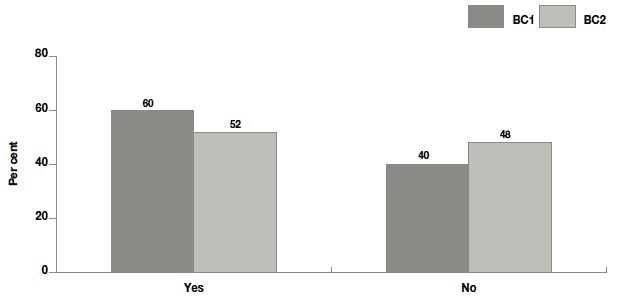
Base - all families: BC1 = 5216, BC2 = 6126
Use of childcare varied considerably according to key socio-economic characteristics. As may be expected, employment - particularly maternal employment - was a key factor influencing use of childcare (Figure 8.2). Households where the child's mother was working part-time (and was not still on maternity leave) were most likely to be using childcare. 78% of these households used childcare compared with 74% of households where the mother was working full-time and 25% where the mother was not working.
Figure 8.2 Proportion of families using childcare by maternal employment status (excluding mothers still on maternity leave)
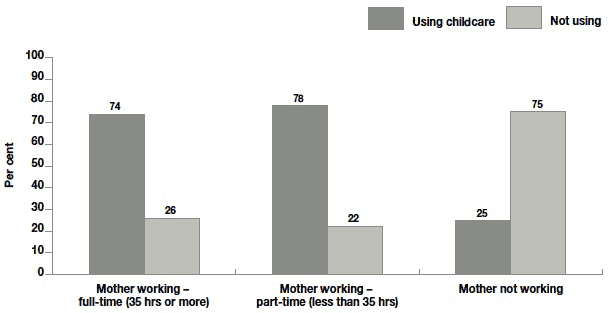
Bases - all families with mother in household where mother was not on maternity leave at the time of interview: Working full-time = 951, Working part-time = 2354, Not working = 2120
The relationship between parental employment and other socio-economic measures such as household income and level of education means that childcare use was also found to be higher in higher income households and in households where parents had higher educational qualifications. For example, 75% of families in the highest income group reported using childcare compared with 65% in the middle income group and 45% in the lowest income group. Similar patterns were also seen in relation to area deprivation although the differences between those in the least and most deprived groups were not as large as in relation to household income (68% compared with 54% respectively).
Variations were also seen by area urban-rural characteristics (Figure 8.3) with the main distinction being between 'accessible' and 'remote' groups. The proportion of families living in urban areas and in other accessible areas (both small towns and rural areas) was broadly similar at between 51% and 56%. Childcare use was considerably lower in remote areas however, at 43% in small, remote towns and 40% in remote rural areas.
Figure 8.3 Proportion of families using childcare by area urban rural characteristics
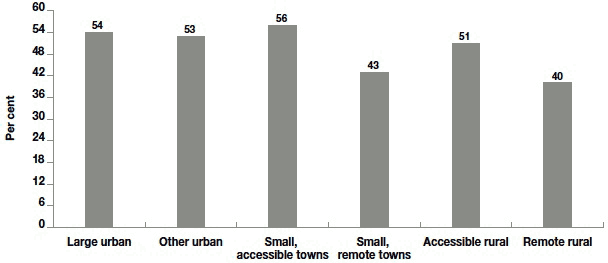
Base - all families. Large urban = 2273, Other urban = 1780, Small, accessible towns = 493, Small, remote towns = 248, Accessible rural = 977, Remote rural = 354
Families in which the respondent was white were more likely to be using childcare than those where the respondent was from another ethnic background. 53% of white respondents reported using childcare compared with 33% of respondents from other ethnic backgrounds.
8.3.2 Number of childcare arrangements
Information was collected on each of the individual childcare arrangements that were in place for the child. The majority of families using childcare (64%) had only one arrangement in place, with most of the rest (a further 30%) having two arrangements. Just 5% were using three or more separate arrangements. There were small, but statistically significant changes in the number of arrangements being used between the cohorts.
Compared with families in BC1, use of a single arrangement had decreased (from 69% to 64%) with a corresponding increase in two arrangements (from 27% to 30%) and three or more arrangements (from 4% to 5%). Thus, whilst overall childcare use had decreased over time, those families using childcare in BC2 were spreading the care required across a greater number of arrangements compared with those in BC1.
The number of childcare arrangements being used varied by family type. Couple families were slightly more likely to be using multiple providers than were lone parent families. 37%
of parents in couple families were using two or more childcare arrangements for the cohort child compared with 33% of lone parents.
Families where the child's mother worked part-time were almost just as likely to rely on multiple childcare providers as those where the mother worked full-time (Figure 8.4). Amongst those using childcare, 37% of families where the child's mother was employed part-time used two or more providers compared with 41% of families where the mother
was employed full-time.
Figure 8.4 Number of childcare providers used by maternal employment status (excluding mothers still on maternity leave)
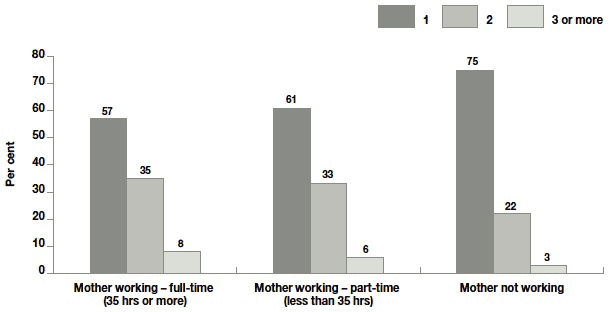
Base - all families using childcare with mother in household where mother was not on maternity leave at the time of interview. Working full-time = 701, Working part-time = 1816, Not working = 513
Higher income families were more likely to be using multiple providers than were lower income families. The key difference was between those families in the top two and bottom three income groups. Amongst those using childcare, around 58% of families in the top two income groups used only a single arrangement with 42% using two or more providers. This is compared with 69% of families in the bottom three income groups using a single childcare arrangement and 31% using two or more.
Ethnicity was associated with the number of childcare arrangements being used. In families using childcare, 80% of those where the respondent was from another ethnic background used only one provider compared with 68% of families where the respondent was white.
The number of arrangements being used did not vary considerably according to area deprivation. For families using childcare, between 61% and 64% of those in the least deprived quintile and in the following three quintiles were using a single arrangement. This figure was a little higher (69%) for families living in areas in the most deprived quintile. There were no statistically significant differences according to area urban rural characteristics.
8.3.3 Types of childcare
To allow a more detailed consideration of patterns of childcare use, parents were asked to indicate, for each childcare arrangement in place for the child at the time of the interview, the type of provision being used. Providers could be selected from a list of 18 different types (and an 'other' category) covering both formal and informal provision. The types of provider listed and their informal/formal allocation are shown in Table 8.1.
Table 8.1 Childcare providers and informal/formal status
| Informal provider type | Formal provider types |
|---|---|
| The child's grandparent(s) | Private crèche or nursery |
| Another relative | Registered childminder |
| Ex-spouse or partner | Local authority playgroup or pre-school |
| The child's older brother or sister | Local authority crèche or nursery |
| A friend or neighbour | Community/voluntary playgroup or pre-school |
| Babysitter who came to house | Private playgroup or pre-school |
| Workplace crèche or nursery | |
| Family centre | |
| Nursery class attached to primary school | |
| Daily nanny who came to our house | |
| Live-in nanny | |
| Child-carer (provided via an agency) |
Detailed provider type
For the purpose of analysis, these more detailed childcare types were grouped into seven summary categories: grandparents, nursery/crèche, childminder, playgroup, family centre, other informal and other formal providers. Figure 8.5 shows what proportion of parents who used childcare were using each of the different summary provider types. Data are also provided for comparison with BC1.
Figure 8.5 Proportion using different types childcare by cohort
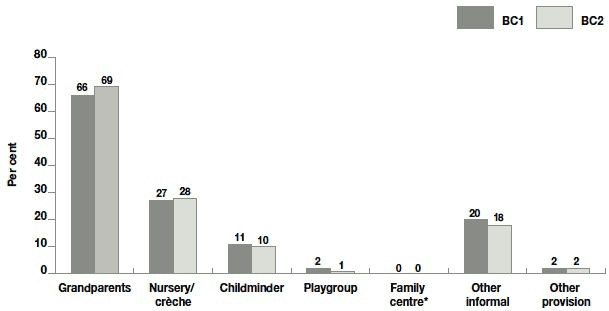
Note: The actual proportion of families using family centres for childcare was not zero but was less than 1%.
Base - all families using childcare: BC1 = 3122, BC2 = 3197
The types of provision being used by families in BC2 were very similar to those used by families in BC1. The most common form of childcare being used was the child's grandparents - 69% of BC2 families using childcare reported using this type of provision. Grandparents were also the dominant form of childcare for families in BC1, though their use has increased slightly - from 66% - since 2005/06. Nurseries were the next most common provider, used by 28% of families using childcare, followed by 'other informal' provision (18%) and then childminders (10%). Only the differences in use of grandparents and playgroups were statistically significantly different between cohorts.
Table 8.2 Proportion of families using particular childcare providers by selected family characteristics
| Grand-parents | Nursery/ crèche | Child-minder | Other informal | Base: families using childcare | |
|---|---|---|---|---|---|
| Maternal age at child's birth | |||||
| Under 20 % | 79 | 9 | 4 | 29 | 160 |
| 30 to 39 % | 66 | 35 | 11 | 15 | 1572 |
| Family type | |||||
| Lone parent % | 67 | 18 | 7 | 32 | 573 |
| Couple family % | 69 | 30 | 10 | 15 | 2624 |
| Area deprivation quintile | |||||
| Least deprived quintile % | 67 | 39 | 11 | 11 | 647 |
| Most deprived quintile % | 68 | 20 | 6 | 25 | 625 |
| Area urban-rural characteristics | |||||
| Large urban % | 65 | 35 | 6 | 18 | 1227 |
| Accessible rural % | 72 | 27 | 13 | 17 | 503 |
Table 8.2 compares the proportion of families using childcare in different sub-groups who were using specific types of childcare provision. As the data show, grandparents were the dominant provider amongst all families. However, younger mothers were particularly likely to be using grandparents for childcare. 79% of teenage mothers reported using grandparents compared with 66% of mothers in their thirties.
Use of nurseries (including private and local authority) was more common amongst older mothers, couple families and those living in areas in the least deprived quintile. In contrast, use of other informal providers was higher for younger mothers, lone parents and those living in the most deprived areas.
The types of childcare being used also varied by area urban rural characteristics. For example, families living in accessible rural areas were more likely to be using grandparents and childminders and less likely to be using nurseries than were parents living in large urban areas. Families in both areas were just as likely to be drawing on other informal provision.
Formal versus informal provision
The seven summary provider types (shown in Figure 8.5) were further condensed to allow a simple analysis of use of any formal provision, use of any informal provision and the extent to which only formal or informal, or a mixture of both types of provision was being used.
As suggested by the information in the previous section, use of informal providers was considerably more common than use of formal providers. 79% of families using childcare were using at least one informal arrangement and 39% were using at least one formal arrangement. Compared with BC1, use of any informal provision has increased from 75%, whereas use of any formal provision has remained static (the figure for BC1 was 40% but the change down to 39% is not statistically significant). As shown in Figure 8.6, 61% of families using childcare were only using informal arrangements, 21% were only using formal arrangements and 17% were using a mix of formal and informal provision.
Figure 8.6 Mix of formal and informal childcare provision by cohort
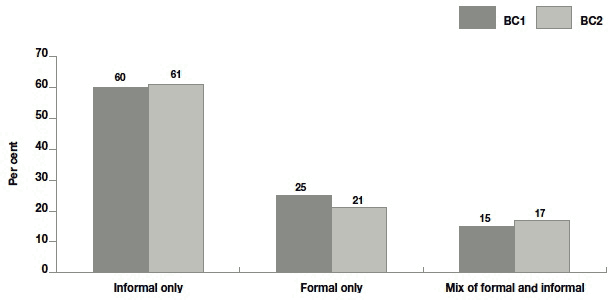
Base - all families using childcare: BC1 = 3122, BC2 = 3197
The graph also provides the equivalent data for BC1. As can be seen, use of only informal providers has remained fairly fixed at around 60%. In contrast, use of only formal provision has decreased slightly from 25% whereas use of a mix of formal and informal provision has increased slightly from 15% to 17%[22]. Thus, compared with families in BC1, although use of any formal provision has not changed (as opposed to formal only, and as indicated above), those who were using formal childcare arrangements in BC2 were more likely to be using them in combination. This links to the increase in the number of arrangements being used also shown above. These changes may reflect the decrease in overall childcare use with those families using childcare in BC2 representing different socio-economic characteristics to those using childcare at BC1, thus impacting on the different patterns of provision being used. It may also reflect changes in the childcare market - such as increased costs, or less choice - meaning that families are having to utilise a greater mix of provision, and a greater reliance on informal care, to meet their childcare needs. These issues will be explored below.
The types of provision being used varied considerably by family socio-economic characteristics. For example, amongst lone parent families, use of informal provision was higher, and use of formal provision was lower, than for couple families. Of those who used childcare, 84% of lone parent families used some informal provision and 27% used some formal provision compared with 77% and 41% of couple families who used childcare respectively. As may be expected therefore, compared with lone parents, couple families were significantly less likely to be using only informal provision (59% compared with 73%) and more likely to be using only formal (23% compared with 16%) or a mix of both (19% compared with 11%).
Families where the child's mother worked part-time were slightly more likely to use some informal childcare than families where the mother worked full-time (79% compared with 73%). However, those where the mother was not employed were most likely to be using informal care (86%). In contrast, families where the mother worked full-time were most likely to be using some formal care. 56% did so compared with 39% of families where the mother worked part-time and 18% where the mother was not employed. Those families where the mother worked full-time were also more likely to be using a mix of formal and informal care (28% compared with 18% amongst families where mothers worked part-time).
Figure 8.7 Mix of formal and informal childcare provision by maternal employment status (excluding mothers still on maternity leave)
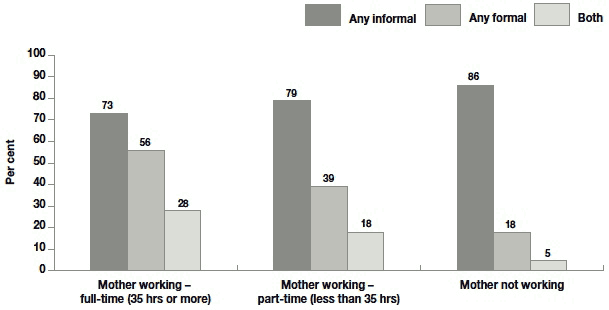
Base - all families using childcare with mother in household where mother was not on maternity leave at the time of interview. Working full-time = 701, Working part-time = 1816, Not working = 513
Compared with those from other ethnic backgrounds, respondents from white backgrounds were more likely to be using any type of informal provision (79% compared with 69%) though the proportions using any formal care did not vary according to ethnicity (around 40% for all respondents). The mix of provision varied however, reflecting ethnic differences
in the number of providers used, shown above. Respondents from White backgrounds, compared with those with other ethnic backgrounds, were more likely to be using a mix of informal and formal care (17% compared with 9%) and less likely to be using only formal arrangements (21% compared with 31%).
Use of informal childcare was greater amongst families in more disadvantaged circumstances, measured either by household income or area deprivation. For example, 83% of families in the most deprived quintile who used childcare used at least one informal arrangement compared with 72% of families in the least deprived quintile. Indeed, as shown in Figure 8.8, as level of area deprivation increased, so did use of only informal provision, whilst use of only formal carers, and use of a mix of formal and informal care decreased.
Figure 8.8 Mix of formal and informal provision by area deprivation (quintiles)
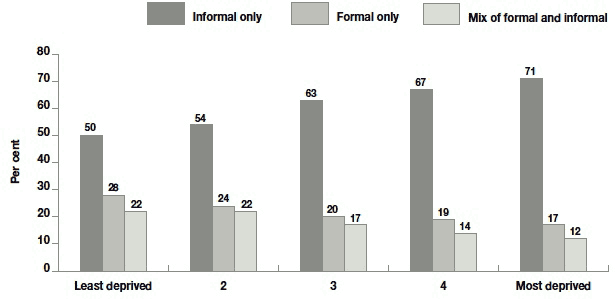
Base - all families using childcare. Least deprived = 643, 2nd quintile = 616, 3rd quintile = 659, 4th quintile = 63, Most deprived = 614
The likelihood of using any informal provision did not vary significantly according to area urban rural characteristics. However, there were some differences in use of any formal provision which was highest in large urban areas (43% of families using childcare used at least one formal provider) and lowest in remote rural areas (31%) though there was no clear pattern in between - for example, use of formal provision was just about as likely in 'other urban' areas as it was in small, remote towns (34% and 36% respectively).
8.3.4 Weekly hours of childcare used
As well as providing details on the person or organisation providing childcare for the cohort child, parents were also asked - for each arrangement - how many hours were used and over how many days those hours were spread[23].
On average, families using childcare did so for 22 hours per week. This is almost identical to the corresponding figure of 21 hours for BC1. 21% of childcare users had arrangements totalling less than 8 hours per week, 20% used childcare for between 9 and 16 hours, 52% for between 17 and 40 hours, and 7% for more than 40 hours.
Employment and, relatedly, household income, were key drivers of the duration of childcare being used for the child. 20% of families using childcare where the child's mother worked full-time (35 hours or more per week) used childcare for more than 40 hours compared with 4% of those where the mother worked part-time. In 60% of the highest income households using childcare, the arrangements spanned between 17 and 40 hours compared with 39% in the lowest income households.
8.4 Reasons for use
8.4.1 General reasons for childcare use
All parents who were using regular childcare for the child were asked what the main general reasons were why they did so (Table 8.3). By far the most common reason given (74%) was to allow the respondent to work. In a third of cases (33%), it was to allow the respondent's partner to work.
Allowing parent's time to get on with other things was less common but appeared in a range of ways. 26% said they used childcare to allow them to attend appointments or go shopping, 17% to allow themselves or their partner a break and 7% so they could look after the home or other children.
The child's interests also featured amongst the reasons. 16% gave the child's social development as a reason, and 8% his or her educational development. 15% said they used childcare because the child liked spending time with, or at, the provider.
Table 8.3 Reasons for using childcare
| All families using childcare % |
All using childcare where mother not currently employed % | |
|---|---|---|
| So that I can work | 76 | 7 |
| So that my husband/wife/partner can work | 33 | 4 |
| So that I can go shopping/attend an appointment/socialise | 26 | 53 |
| To give me/my partner a break | 17 | 43 |
| For child's social development | 16 | 14 |
| Because my child likes spending time with/at the provider | 15 | 31 |
| To allow other relative/carer to spend time with the child | 13 | 27 |
| For my child's educational development | 8 | 7 |
| So that I can look after the home/other children | 7 | 17 |
| So that my husband/wife/partner can study | 5 | 12 |
| So that I can look for work | 2 | 7 |
| So that my child can take part in a leisure activity | 2 | 2 |
| Other reason | 2 | 6 |
| So that my husband/wife/partner can look for work | 1 | <1 |
| So that my husband/wife/partner can study | 1 | 1 |
| Respondent/partner has had illness | 1 | 1 |
| Base (all families using childcare) | 3196 | 512 |
Given the dominance of employment as a key reason for use of childcare, reasons for use were examined for those families where the mother was not currently in employment (Table 8.3). The main reasons given amongst parents in this group were to allow them to socialise or attend appointments, to give the parent(s) a break, because the child liked spending time at the provider or to allow another relative or carer to spend time with the child. These parents were also more likely to cite their own studying or education as a reason for using childcare (12% compared with 5% of all parents using childcare).
8.4.2 Reasons for using specific providers
As well as collecting general reasons for using any type of childcare, parents were also asked to give up to three reasons why they were using a particular childcare arrangement or provider. Table 8.4 compares the 10 most common reasons given for three different childcare types - grandparents, private nursery and childminder[24].
Being able to trust the provider was a dominant driver of using grandparents. Families using grandparents also cited the importance of the provider-child relationship ("I wanted someone who would show my child affection") and the particular approach to care ("I knew they would bring up my child the same way I would").
Trust was less important for families using private nurseries, though still featured as a key reason given for using this type of provision. Affection and approach to care were significantly less important in relation to nurseries. Instead, giving the child the opportunity to mix with other children, the nursery's location, reputation, and staff accreditation were important. Already having had children attend was also a key reason given.
Reasons for using childminders reflect both its similarity to grandparent care - in that it is provided by an individual offering a more personal approach - and nursery care - in that it is a formal, registered service delivered by qualified personnel. Thus trust was of key importance for users of childminders, with affection and approach also some of the top reasons given, unlike for nurseries. Similar to nurseries was the importance of social opportunities for the child and the qualifications of staff.
Table 8.4 Ten most common reasons given for using particular childcare providers and proportion of parents who gave them
| Grandparents | Private nursery/ crèche | Childminder | |
|---|---|---|---|
| Reason given | % | % | % |
| I could trust this person/these people | 85 | 35 | 62 |
| I wanted someone who would show my child affection | 49 | 5 | 21 |
| I knew they would bring up my child the same way I would | 44 | 5 | 21 |
| I could not afford to pay for formal childcare | 27 | 0 | 3 |
| I wanted my child to be looked after at home | 15 | 0 | 5 |
| I wanted my child to mix with other children | 1 | 38 | 28 |
| It had a good reputation | 0 | 32 | 13 |
| It is easy to get to | 6 | 29 | 15 |
| His/her brother(s)/sister(s) went there | 5 | 27 | 15 |
| I wanted someone properly trained to look after my child | 0 | 24 | 25 |
| All families using particular childcare provider | 1840 | 674 | 270 |
8.5 Cost
Of those who use childcare, 41% are required to pay whereas for 58% the childcare is free and for 1% someone else pays for it. There are no significant differences in these figures when compared with BC1.
Amongst those who pay for the cohort child's childcare (unweighted n = 1343), the average weekly cost was £88. For parents in BC1 who paid for childcare, the reported average weekly cost was lower, at £66. Adjusting the BC1 costs for inflation[25] shows £66 in 2005/06 to be equivalent to £76 in 2011/12 prices (the closest equivalent for BC2 cost data). Thus, in real terms, there has been an average increase in childcare costs for a 10-month-old child of £12 per week, or approximately £624 per year.
7% of parents in BC2 paid up to £20 per week, 23% paid between £21 and £50, 36% paid between £51 and £100, and 33% paid over £100.
Those parents who paid for any childcare, for either the cohort child or other children in the family, were asked how easy or difficult they found it to pay. The results are shown in Figure 8.9, alongside those for BC1. As the graph shows, the rise in childcare costs appears to have made it more difficult for parents to meet those costs. The proportion of parents reporting that childcare costs were 'very easy' to pay has reduced slightly from 14% to 10% whereas the proportion saying costs were difficult to pay increased a little from 21% to 24%.
Figure 8.9 Ease of meeting childcare costs by cohort
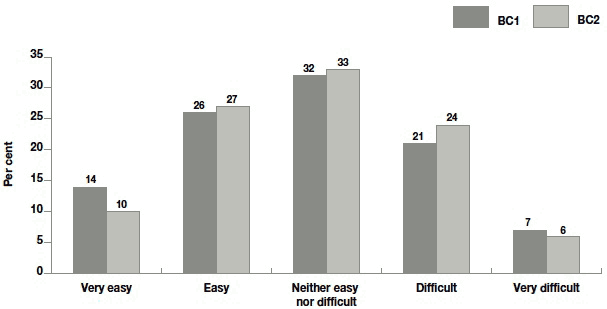
Base - all families using childcare who pay for that care: BC1 = 1584, BC2 = 1690
As may be expected, families in more disadvantaged circumstance were more likely to report some difficulty in meeting their childcare costs. For example, 36% of families using childcare living in the most deprived quintile said meeting their childcare costs was difficult or very difficult compared with 24% of those living in the least deprived quintile. It is notable, however, that a significant minority of families in more advantaged socio-economic circumstances still report difficulty in meeting childcare costs.
8.6 Practicalities
8.6.1 Ease of making childcare arrangements
Parents were asked how easy or difficult they had found it to arrange suitable childcare for the cohort child. The vast majority of parents said they found it very (46%) or fairly (39%) easy. Only 11% said it had been difficult, including just 3% who said it was very difficult.
Families in the highest income group were more likely to say they found arranging childcare 'very easy' than those in the bottom income group (54% compared with 39%). However, ease of arranging did not consistently decrease with household income. Parents in the middle income group reported greater ease than those in the second and fourth quintiles.
There were no statistically significant differences in the ease of arranging childcare by area urban rural characteristics.
Reasons for difficulty in arranging childcare
Those parents who said they had found it fairly or very difficult to arrange childcare (unweighted n = 325) were asked why. The most common reason, given by 45% of the parents asked, was a lack of availability. Cost was cited by 15% whilst difficulty caused by irregular or unusual working hours was mentioned by 8%. 6% did not like some childcare providers and 2% thought their child was too young to be separated from his/her carer.
A range of specific other reasons were given by 38% of the parents indicating the many different and complex factors affecting the choice of childcare for families.
8.6.2 Perceived degree of choice
Parents were asked to think about the affordable and available options open to them at the time they were arranging childcare for the cohort child and to indicate how much choice they felt they had when making those arrangements.
11% of those using childcare felt they had a great deal of choice with a further 34% reporting 'quite a lot' of choice. 42% said they hadn't very much choice and 13% felt they had none at all. There has been a favourable change in these perceptions since 2005 with parents in BC2 generally perceiving greater choice in their childcare than parents in BC1. Compared with BC1, parents in BC2 were significantly more likely to report having 'quite a lot' of choice (increase from 26% to 34%) and less likely to report no choice at all (decrease from 22% to 13%).
Whilst experiences of arranging suitable childcare clearly varied, there were no obvious trends according to family socio-economic characteristics. For example, parents using childcare in the lowest income quintile were slightly more likely than those in the third and fourth income quintiles to say they had either 'quite a lot' or 'a great deal' of choice (46% compared with 42% and 44% respectively). However, those in the highest income groups were most likely to perceive greater choice (53% said either 'quite a lot' or a 'great deal of choice').
Patterns by area deprivation were similar. 53% of parents living in the least deprived areas said they had either 'quite a lot' or a 'great deal of choice' but those in all other areas had similar views - between 41% and 45% gave the same response.
These patterns most likely reflect the different mix of formal and informal provision available to and being drawn upon by families in different circumstances.
8.7 Parental leave and family-friendly working
8.7.1 Maternity leave and pay
A little over three-quarters (78%) of mothers were employed during their pregnancy with the cohort child. Of these, 88% took maternity leave with the remainder leaving that particular job. These figures are broadly in line with those from BC1.
Almost all mothers (93%) who went on maternity leave took at least six months. However, many took longer: 46% took between six and 10 months, and 38% took 10 months or more.
As shown in Figure 8.10, duration of maternity leave was much longer for mothers in BC2 than BC1 reflecting the changes to relevant legislation in the period between the birth of children in the two cohorts. The proportion of those who took leave doing so for between six and 10 months, and for 10 months or more, doubled (from 22% to 46%, and 18% to 38% respectively). As a consequence, the proportion taking up to six months decreased from 60% in BC1 to 16%.
Figure 8.10 Duration of maternity leave by cohort
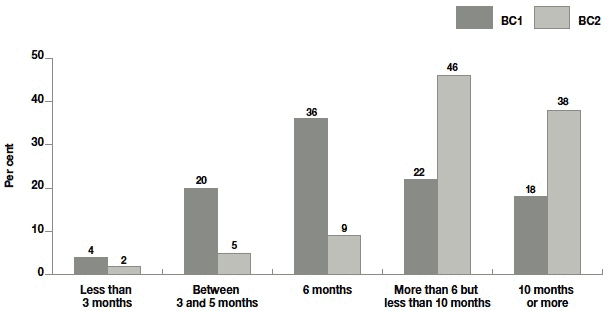
Base - all families where mother took maternity leave: BC1 = 3175, BC2 = 3917
Only 4% of those mothers who took maternity leave did not receive any pay. Amongst those who were paid, 95% received statutory maternity pay, 49% received additional maternity pay and 6% received some other type of pay during their leave.
8.7.2 Paternity leave and pay
In couple families, 78% of respondent's partners who had ever been employed had taken some leave since the child was born. Of these, most (65%) had taken paternity leave, but reasonable proportions had also taken annual leave (35%) or parental leave (18%).
18% of partners who took leave following the child's birth took less than two weeks, 57% took two weeks, 23% took between two and eight weeks and 2% took more than eight weeks.
8.7.3 Employer's family-friendly policies
72% of parents who were currently or had been employed said their employer offered at least some policies aimed at family-friendly working. The proportion amongst those who were working at the time of the interview was slightly higher at 85%. This represents a significant increase from 60% in BC1[26]. The range of policies offered, and the proportion of working parents who reported each being offered by their employer, is shown in Table 8.5.
Table 8.5 Family-friendly policies offered by parents' employers
| Family-friendly policies | % |
|---|---|
| Childcare vouchers | 36 |
| Flexible working hours always possible | 34 |
| Allows parents unpaid time off when a child is sick | 33 |
| Allows parents paid time off when a child is sick (in addition to normal holiday allowance) | 31 |
| Flexible working hours sometimes possible by arrangement | 30 |
| Allows employees option to job-share | 19 |
| Allows employees to work from home some or all of the time | 13 |
| Allows parents unpaid time off during school holidays | 8 |
| A work place créche or nursery | 5 |
| Subsidised childcare | 2 |
| Something else | 1 |
| None | 28 |
| Base: All respondents currently working or having previously worked | 5168 |
The most common policy available was childcare vouchers. This was reported by 36% of parents who were currently or had been employed. Flexible working and paid or unpaid leave when a child is unwell were both similarly common. Less common were opportunities for job sharing or home working, reported by 19% and 13% respectively. Even fewer reported unpaid leave during school holidays, subsidised childcare or a workplace nursery.
Parents in BC2 were more likely than those in BC1 to rate their employer as very or fairly good in terms of allowing family-friendly working (71% compared with 64%). This is perhaps unsurprising given the corresponding increase in availability of family-friendly policies for parents noted above.
8.7.4 Attitudes to employment and childcare
Parents who worked less than 20 hours per week were asked how much they agreed or disagreed with the following statement: "If I could afford good quality childcare which was reliable and convenient, I would work more hours." Responses for both cohorts are shown in Figure 8.11.
Figure 8.11 Agreement with statement "If could afford good quality childcare which was reliable and convenient, I would work more hours" by cohort
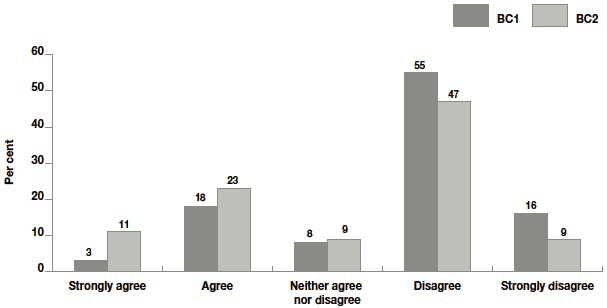
Base - parents who worked less than 20 hours per week: BC1 = 939, BC2 = 925
The graph shows that parents in BC2 were more open to the prospect of increasing their working hours if they were able to access good quality childcare which was reliable and convenient. 11% strongly agreed and 23% agreed with the statement in BC2 compared
with 3% and 18% in BC1. An alternative interpretation is that accessing childcare appears
to have been more of a barrier for parents increasing their working hours in 2011 than it
was in 2005/06.
8.8 Summary
The changes to maternity leave and pay introduced by the Work and Families Act 2006,
and which affected mothers whose babies were born after 1st April 2007, have had a clear impact on use of childcare for children aged 10 months in Scotland. Overall, use at this age has declined, from 60% in 2005 to 52% in 2011. This decline is largely explained by an increase in the proportion of mothers who were still on maternity leave at 10 months and who therefore did not yet require childcare.
A number of other notable differences in patterns of childcare use are evident between the two cohorts. Parents in BC2, whilst using childcare for a similar average number of hours each week, spread those hours over a greater number of providers. This change is also reflected in the types of provision used; parents in BC2 were more likely to be drawing on some informal provision - though their use of formal providers remained similar to parents in BC1. The suggestion is, therefore, that formal provision is being used for shorter durations by BC2 parents who nevertheless still need it in some respect.
The potential reduction of hours of formal provision used may be explained by the significant rise in childcare costs between the two cohorts. Had cost of childcare risen purely in line with inflation from 2005, the average weekly cost for parents in 2011 would have been £76, based on GUS data. Instead, the average weekly cost reported by BC2 parents was £88. The rise in costs was accompanied by a small rise in the proportion of parents who reported finding it difficult to meet those costs.
Aside from saving money by reducing the hours of formal provision, requiring a greater number of childcare providers than those in BC1 could potentially be explained by BC2 parents finding it harder to source the childcare they needed from a single provider and, overall finding it more difficult to make the arrangements necessary. Yet this is not reflected in the data. The vast majority of parents said they found it easy to arrange their childcare and they also felt they had more choice. This suggests that childcare information resources, such as the Scottish Family Information Service, are improving parents' knowledge and awareness of the services available to them.
Despite small shifts in the broad mix of informal and formal childcare provision used, the dominant specific types of childcare provision were similar between the two cohorts. Grandparents emerge, by far, as the most popular provider, followed by nurseries. There was a notable difference in the reasons given by parents for using specific types of provision. In particular, whilst aspects of 'nurturing' - for example, through showing the child affection - was a common reason cited for using grandparents, it was very rarely cited in relation to nurseries. This may therefore be an area worth developing, or marketing, in relation to nursery provision to increase the appeal of nursery care for parents with young children who may otherwise rely wholly on grandparents for care.
It's not possible to directly assess whether or not commitments contained in the EYF to promoting childcare vouchers have been successful as BC1 parents were not explicitly asked about this facility. However, on the whole, family-friendly working does appear to have improved. Compared with BC1, more working parents in BC2 reported the availability of family-friendly policies and rated their employer as fairly or very good in terms of allowing family-friendly working.
8.9 References
Children in Scotland (2011) The Cost of Childcare in Scotland: A special report Edinburgh: Children in Scotland.
National Statistics Publications for Scotland (2010) PRE-SCHOOL AND CHILDCARE STATISTICS 2010, Edinburgh: Scottish Government.
Scottish Government (2012) A Scotland for Children: A Consultation on the Children and Young People Bill, Edinburgh: Scottish Government.
Scottish Government (2011) Early Years Framework: Progress So Far, Edinburgh: Scottish Government.
Scottish Government (2007) Maternity Leave. Edinburgh: Scottish Government,
http://www.scotland.gov.uk/Resource/Doc/76007/0060971.pdf
Contact
Email: Sharon Glen
There is a problem
Thanks for your feedback